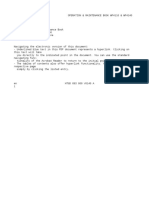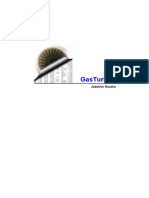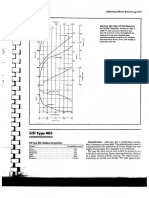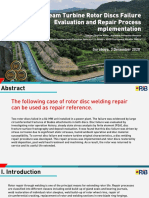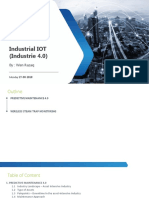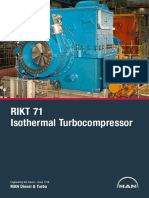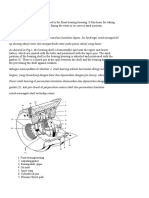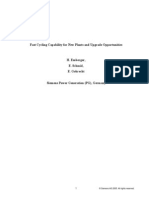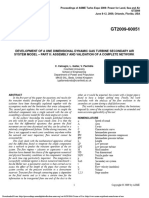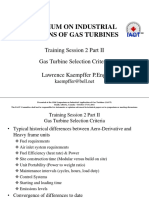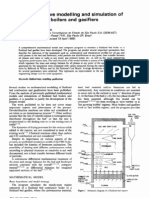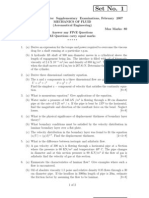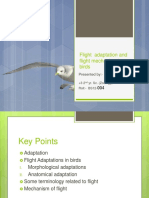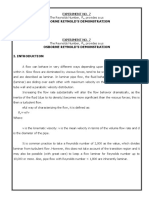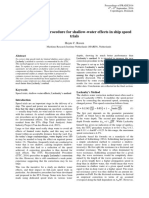GT2005-68014 Axial Compressor Maintenance PDF
GT2005-68014 Axial Compressor Maintenance PDF
Uploaded by
Raden MasCopyright:
Available Formats
GT2005-68014 Axial Compressor Maintenance PDF
GT2005-68014 Axial Compressor Maintenance PDF
Uploaded by
Raden MasOriginal Title
Copyright
Available Formats
Share this document
Did you find this document useful?
Is this content inappropriate?
Copyright:
Available Formats
GT2005-68014 Axial Compressor Maintenance PDF
GT2005-68014 Axial Compressor Maintenance PDF
Uploaded by
Raden MasCopyright:
Available Formats
Proceedings of GT2005
ASME Turbo Expo 2005: Power for Land, Sea and Air
June 6-9, 2005, Reno-Tahoe, Nevada, USA
GT2005-68014
AXIAL COMPRESSOR PERFORMANCE MAINTENANCE
Philip Levine/Fern Engineering, Inc. Leonard Angello/EPRI
ABSTRACT Symbols:
Methods of compressor performance maintenance for large air angle
utility combustion turbines continue to evolve. On-line water δ film thickness
wash systems used to recover performance loss due to fouling ω pressure loss coefficient
are evolving that use less water. This paper derives a water µ viscosity
wash model based on a thin film of water covering the airfoil ρ density
surfaces. shear stress
The economic potential for recovering “unrecoverable” Subscripts:
losses due to increased roughness and erosion is evaluated. As a air
an outage is needed to remove the compressor cover and w water
perform the maintenance, the approach is to identify the most o reference conditions
beneficial maintenance actions and an optimal maintenance 1 inlet condition
interval. 2 outlet condition
Keywords: Axial Compressors, Water Wash, Combustion
Turbines INTRODUCTION
Compressor performance maintenance is recognized as
NOMENCLATURE paramount to achieving the full capability of a combustion
C chord turbine and/or combined cycle. Daily on-line water washing is
D drag effective in recovering compressor aerodynamic efficiency due
ES spark spread to fouling. It is not the intent to review all the relevant design
H blade height features of a water wash system, but rather to investigate the
HR heat rate rationale for an adequate water flow rate impinging on the
Ks sand roughness airfoil surfaces. The water flow rate is important due to the
OC outage cost potential for consequential erosion on some compressors and to
P power limit de-mineralized water consumption. A water wash model
Ra roughness average based on a water film covering the airfoil surface is
RC repair cost hypothesized to estimate the minimum water requirements and
S blade spacing to define the important related compressor and operating
SF scale factor parameters.
U water velocity at edge of film Blade restoration is addressed to recover what is
W water flow rate considered the “non-recoverable losses” due to roughness,
g gravitational constant erosion and corrosion. An economic model is shown to indicate
u local film velocity the potential for an optimum outage interval to repair the
compressor based on loss model and economic parameters.
1 Copyright © 2005 by ASME
ON-LINE WASHING Calculated results of a stage stacking and associated cycle
analysis by Levine [6] found that the combustion turbine power
Compressor Fouling Phenomena and heat rate losses are most sensitive to the condition of the
Compressor fouling is due to the size, amount, and first several compressor stages as shown in Fig. 2.
chemical nature of the aerosols in the inlet air flow, dust, 1
insects, organic matter such as seeds from trees, rust or scale
from the inlet ductwork, ingested water as a result of carry-over 0.9
from a media type evaporative cooler, deposits from dissolved 0.8
solids in a water spray inlet cooling system, oil from leaky
compressor bearing seals, ingestion of the stack gas or plumes 0.7
Relative Loss
from nearby cooling towers.
Advances in the design of inlet filters have resulted in high 0.6
filter efficiency as shown in Fig. 1, but nevertheless fouling Thermal Efficiency
0.5
persists as the very fine particles get through and as a result of
by-pass leakage or poor installation and/or maintenance. 0.4
Power
0.3
0.2
1 2 3 4 5 6 7 8 9 10 11 12 13 14 15 16 17
Stage Number
Figure 2. Estimated Effects of Compressor Stage
Loss Coefficient on GE 7EA CT Power and Thermal
Efficiency Performance (Levine [6])
The stage losses shown in Fig. 2 are normalized with those
for the first stage for the same pressure coefficient change. As
the intensity of the fouling is likely to decrease as the stage
number increases, the net combustion turbine performance
losses due to stage location are likely to decrease more rapidly
than shown in Fig. 2.
To deal with the fouling phenomena described above, an
on-line water wash system must provide the frequency,
Figure 1. Capture Efficiency of Filters (Sawyer [1]) duration and flow rate and wash mechanisms to lift and/or
dissolve the deposits due to the on-going accretion of fine
Theoretical studies by Menguturk and Sverdrup[2], and by particles. The injected water wash spray must also have unique
Parker and Lee [3] have contributed to the understanding of the characteristics to achieve water wash effectiveness for the first
fouling mechanisms. Fine particles adhere to rotating blades several stages.
due to their stickiness that is sufficient to hold the particles
even on the rotating blades where the centrifugal forces are
Water Wash Mechanisms
high. Particles less than 1 micron in diameter diffuse to the
surface at a rate proportional to their concentration. Transport
Water Film Flow Model
of larger particles to the surface is enhanced by turbulent
An on-line water wash system consists of an array of water
mixing and diffusion. Tests by Parker and Lee [3] show the rate
nozzles intended to completely wet the airfoil surfaces the inlet
of particle deposition varies around the airfoil, effectively
guide vanes. Searching for an understanding of the actual
changing the shape of the airfoil as the deposits build up.
washing mechanism, a flow model is hypothesized as shown in
The effects of both fouling and roughness on rotor blade
Fig. 3 of a water film covering the entire compressor airfoil
efficiency were tested by Turner and Hughes [4]. The test
surfaces. The aim of the model is to arrive at means to estimate
results demonstrated that fouling and roughness decrease the
the water flow requirements to achieve a water film of an
efficiency in a similar way. Therefore, boundary layer
average specified thickness.
measurements on rough airfoils are likely to be indicative of the
The droplet impacts around an airfoil are not uniform, as
effects of fouling as well. Careful flow measurements by
the inertial effects that cause the impacts are more strongly felt
Bammert and Milsch [5] of the effects of roughness on an
on the leading edge and the pressure side of an airfoil.
airfoil indicate that the boundary layer thickens much more on
Nevertheless, a simplified average film thickness model serves
the suction side than on the pressure side effectively changing
to initially identify parameters that may lead to a better
the airfoil shape to one that is thicker and has less curvature
understanding of the water wash phenomena.
(less camber). These boundary layer changes and the deposition
pattern result in the observed losses in compressor
performance.
For multiple stage compressors, it is of interest to assess
the effect of the stage location on relative losses due to fouling.
2 Copyright © 2005 by ASME
Figure 3. Water Film Formed on an Airfoil by
Impinging Droplets
An estimate of the water film thickness formed by the
droplet impacts and the film flow velocity is based on two
conditions: 1) the water film must cover the entire blade
surface to effectively clean the surface, and 2) there is a viscous
shear stress in the water film that transfers the aerodynamic
drag to the surface of the blade. At the interface between the air
and the water film the water velocity is much lower than the air Figure 4. Airfoil Drag and the Total Pressure Loss
velocity, so the drag by the air is assumed to be the same as it Coefficient (Horlock [7])
would be on a solid surface under the condition of no slip. The
fluid shear stresses in the air and the water at the interface are An average surface shear stress is estimated by balancing
the same. The shear stress at the surface is assumed to be the the drag the airfoil with the total pressure losses such that,
same as that at the interface, so the drag of the air is transferred approximately:
to the surface. The description above translates into the
following expressions for the water flow rate for a surface of τ = ω ρa V2(S / C)cos(αm) / (4g) Eq. (4)
height (H) and a film thickness of (δ) on both sides:
where ρa is the air density, V is the relative air velocity to the
W = water flow = 2 ρwuw δ H Eq. (1) airfoil, ω is the total pressure loss coefficient, S is the spacing,
C is the chord and αm is mean flow angle relative to the axial
where ρw is the water density and (uw) is the average axial direction. Estimates of the average shear stress, τ, based on data
water velocity in the film. The effects of body forces on the for the minimum pressure coefficient are likely to be
fluid film are neglected. In order to calculate the water rate conservative as there may be other losses due to the incidence
flow, a relationship is needed between the average water angle, trailing edge loss and separation. Equating the air-drag
velocity and the film thickness. The approach relates the shear stress and the water film shear stress, the water velocity at
boundary condition that the shear in the water film transfers the the film edge is:
aerodynamic drag to the airfoil surface. The shear in the water
film is simply estimated as: U = τ δg / µ Eq. (5)
τ = shear stress = µ / g (du / dy) Eq. (2) The thickness of the film (on both sides of each blade)
should be larger than the anticipated size of the particles that
where (µ) is the viscosity of water and du/dy is the gradient of form the deposits (see Fig.1), but limited so as to minimize
the water velocity normal to the surface. Note that u = 0 at the water consumption. An example case of δ =1 mil, (25 microns)
surface under the condition of no slip, and since the shear is and a 1st stage rotor is given to illustrate the calculations. The
transferred to the surface, it is assumed constant so that du/dy = velocity at the edge of the film is calculated for the following
U/δ where U is the velocity at the edge of the film and δ is the conditions: ω =.01, ρa = 0.07 lbs/ft3 (1.1 kg/m3), V = 800 fps
film thickness. The shear stress in the water film becomes: (243.8 mps), δ = 0.001/12 ft (25 microns), µ = 0.0006 lb/ft-sec
(0.0009 kg/m-sec), S/C = 0.7, αm = 40 deg. resulting in τ = 1.7
τ = µU / (gδ) Eq. (3) lbs/ft2 (8.3 kg/m2) and U = 7.7 fps (2.35 mps).
The water flow required for the above film parameters on a
The shear stresses due to the air flow vary around an airfoil rotor, wet on both sides, and the blade height is H = 1 ft (0.305
due to the initial laminar flow, transition to turbulent flow, m) and N = 30 blades in the blade row is:
roughness, airfoil shape and velocity distribution. As an initial
step to simplify the model derivation an average shear stress is W = ρw Uδ H N= σw τ δ2g/µ H N = 1.2 lbs/sec Eq. (6)
estimated based on the measured pressure loss coefficient. The
pressure loss coefficient is defined as the ratio of the total (8.6 gpm (33 lpm), or 0.2% of the air flow)
pressure difference for the airfoil due to the aerodynamic losses
divided by the dynamic pressure of the air flow relative to the The estimates above correspond approximately to the pitch
airfoil. radius for to a CT such as a GE 7E CT and an air/water ratio of
The relationship between the drag force and the total 500.
pressure loss coefficient is shown in Fig. 4.
3 Copyright © 2005 by ASME
Application of the Water Film Model film scales as Wa / W ~ (Wa)1/2. Scaling results are shown in
Besides the water flow needed to sustain a water film, Fig. 4 for the estimated variation of the air/water ratio with CT
some of the injected water droplets may evaporate or be power output for a water film with no evaporation and with
ineffective. As a water wash system nozzle emits a spray with a evaporation. The results shown depend on the specific power of
droplet size variation, the finer droplets tend to evaporate the CT and in this case, high efficiency large CTs were
and/or follow the streamlines without benefiting the water considered.
wash. There may also be evaporation from the surface of the For a CT with a high efficiency filter, the surface deposits
water film due to convection. are likely made up of very fine particles as shown in Fig. 1 so
The water film model may be applied to each blade row of that a film thickness that could lift or dissolve the deposits
a compressor. The water wash spray first encounters the inlet could be as low as ten microns which would result in an
guide vanes (IGVs), where the injected water losses to air/water ratio as high as 3,000. The formation and stability of
evaporation are likely to be low. For the case where there is a the thin film from relatively large impinging droplets may be
fogger or evaporative cooler in the CT inlet, the nearly enhanced by the aerodynamic shear stress that stretches and
saturated flow leaving the inlet will condense some of the water flattens the droplets until they merge into a thin film. The
vapor to droplets as the air flow velocity increases, depressing rationale for effectively using a very thin film is to increase the
the air flow static temperature at the IGVs. This condensing cleaning frequency so that thickness of the deposits is reduced.
phenomenon is prominent when the inlet temperature is
lowered to the point where the condensed droplets form ice Air/Water Ratio vs. CT Power
particles. As a result of the condensing process, heat is released 800
and the air flow temperature decrease is smaller, but the inlet
700
guide vanes may still experience saturated air flow with water
droplets without any injected water. Whereas the saturated 600
condition limits further evaporation in the IGVs, the size of the
droplets formed may be very small so that most of them may 500
Air/Water Ratio
travel with the streamlines around the airfoils. The droplet size 400
film only
film + evaporation
resulting from condensation is likely to be dependent on the
concentration of contaminates in the air that serve as nuclei for 300
droplet formation. 200
In the case of low relative humidity at the compressor inlet,
the relative humidity at the IGVs increases due to the increased 100
air flow velocity so the disposition for evaporation of the 0
injected water is decreased. Therefore, the injected water flow 0 50 100 150
CT Power, MW
200 250 300
estimate based on the water film alone on the IGVs may be
adequate. Experience confirms that the amount of water vapor Figure 4. Estimated Air/Water Ratios Needed to
entering via the inlet air can be beneficial to the washing Sustain a Water Film, δ = 0.001 inches (25 microns)
mechanism (Stalder [8]). However, for the water wash benefit
to extend to one or more stages, one must consider evaporation The results of a survey by Mund and Pilidis [9] of on-line
losses. water wash systems correlated the air/water ratio with CT
The evaporation in the 1st rotor depends on the output power and the results are shown in Fig. 5. The systems
aerodynamic reaction of the blade design as an impulse design are categorized by high or low pressure (HP, LP) and high,
would have no static temperature rise through the blade row. medium and low flow (HF, MF, LF). The similarity of the
The maximum droplet and surface film evaporation rate in the correlation with the results for the example model in Fig. 4 is
1st stage to saturate the air flow depends on the stage pressure evident.
ratio and may require an air/water ratio of ~ 200. This result is Limited information on the amount of water injected
found by a stepwise calculation adding water during the provided by Mund and Pilidis [10] notes a variation in the
compression of the air so as to keep the air saturated. The water injection duration from less than 1 minute to as much as 30
flow corresponding to the example above needed to keep the air minutes. If a duration of 1 minute is sufficient, the total water
saturated in the 1st stage and maintain the water film thickness usage in the example case described above could be as little as
of 1 mil (25 microns) is 30 gpm (116 lpm), bringing the 27 gallons (104 liters). The use of anti-fouling coatings could
potential total injected air/water ratio to ~ 150. Utilizing a spray likely reduce the duration of the water pulse needed to recover
with large droplets slows the droplet evaporation such that the the performance loss. Whereas the model presented provides
air is not saturated in the first stage, reducing the amount of added insight into the water washing mechanisms, ultimately
water required. the water flow rate and duration that minimizes water
A water film scaling relationship for the air/water ratio for consumption is best established by performance monitoring.
aerodynamically similar compressors but of different size may The mechanical and control elements of the wash system must
be derived as the product of HN may be written as: HN = H / C have flexibility to conveniently adjust the water flow rate and
× C/S × πD, where H/C = aspect ratio, S/C = solidity, D = pulse interval.
compressor diameter.
The air flow (Wa) may be expressed as Wa ~ D2 × (1 -
HTR2), where HTR is the hub/tip ratio. Therefore, for
aerodynamically similar compressors, the air/water ratio for the
4 Copyright © 2005 by ASME
Inspection of Fig. 6 shows that the blade losses change
very little until a critical amount of roughness is added,
corresponding to a Reynolds number of 90. As shown, if the
initial roughness is much less than the critical amount then
roughness losses are delayed until the critical roughness is
reached. These results suggest that very smooth coatings with a
roughness of 15 micro-inches will likely yield higher
aerodynamic efficiencies for a longer time.
Erosion Phenomena
The use of foggers, evaporative coolers and inter-stage
cooling raises concerns of impingement of droplets on the
airfoils. Droplets may cause erosion in highly stressed blade
Figure 5. Air-Fluid Ratio for Different Compressor
sections such as the root of the 1st rotor. The total water
Washing Systems (Mund and Pilidis [9])
ingested into the compressor is the sum of the carry-over of
unevaporated droplets from foggers, evaporative coolers and
COMPRESSOR BLADE RESTORATION
the injected water from a water wash system. As a precaution,
the airfoils should be inspected in accord with OEM
Airfoil Roughness Phenomena recommendations.
Airfoil roughness is caused by particle impingements and Leading edge erosion also causes a loss in compressor
corrosion. The aerodynamic effects on roughness are often efficiency due to sharp corners resulting from increased
tested by simulating the roughness with sand paper bluntness. When water droplets entering the compressor are
characterized by a sand roughness height, Ks. These tests have anticipated due to evaporative cooling, fogging, or on-line
shown that there is a roughness height that corresponds to a washing, a corrosion and erosion resistant coating should be
condition of hydraulic smoothness where there are no effects of considered, at least to the first several stages depending on
roughness. The condition for smoothness is that the roughness experience with similar CTs and the OEM’s recommendations.
Reynolds number is less than 90, e.g., see Koch [11], so that: If blunting of the leading edge of a blade occurs as shown
in Fig. 7, it results in changes in smoothness of the air flow
Sand Roughness Reynolds Number = around the leading edge [12]. Leading edge blunting may
V × Ks × density / viscosity <= 90 introduce a rapid change in curvature (possibly a sharp corner)
as shown in Fig. 8 such that the flow velocity increases rapidly
To make use of the test data using sand roughness when and then is unable to stay attached to the surface downstream of
performing average roughness (Ra) measurements using a the leading edge resulting in a flow separation, a pressure loss
contact surface tester stylus that is dragged over the surface, it and an efficiency loss. This loss gets worse as blunting
is estimated that Ks = 6.2 × Ra. Therefore, the critical condition continues. If the leading edge is restored then new material
for smoothness is an average roughness (Ra) Reynolds number should be added to the leading edge so the original contour is
of approximately 15. On a 1st stage vane, the critical value of re-captured.
Ra may be as much as 70 micro-inches (1.778 microns).
Because of the high relative air flow speed on the 1st stage
rotor, the critical roughness could be as low as 25 micro-inches
(0.635 microns). Test results by Bammert and Milsch [5] on
airfoils with sand roughness are shown in Fig. 6.
Figure 7. Blunting of an Airfoil Due to Erosion and
Refurbishment Options [12]
o - From wake survey
× - From boundary layer measurement
Figure 6. Effect of Surface Roughness on Flow
Friction Losses for a Ratio of Blade Spacing to Chord
Length of 1.25 and a Reynolds Number = 4.3 × 105
(Bammert & Milsch [5])
5 Copyright © 2005 by ASME
ECONOMIC OPTIMIZATION OF COMPRESSOR
BLADE RESTORATION
Compressor Blade Restoration Plan
The cost of on-line washing to recover losses due to
fouling is relatively low and operators tend to wash daily to
defer off-line washes and maintain high efficiency. In the case
of non-recoverable losses, the approach is to determine an
outage maintenance interval that in effect recovers the cost of
the outage (lost revenue) and reduces losses as a result of
compressor blade repair such as coating or restoration. At issue
is whether the costs and benefits of additional compressor
inspections and maintenance are economically justified. A
Figure 8. Leading Edge Induced Flow Separation Due typical non-recoverable performance curve is shown in Fig. 9
to Erosion [12] (The x-axis is the ratio of the distance which includes the turbine section losses as well as the
from the leading edge to the chord.) compressor losses. However, the turbine rate of degradation is
much slower than that for the compressor, so the curve may be
Detection of the Condition of the Compressor used as a conservative estimate for the short term non-
The detection of the condition of the compressor can be by recoverable compressor losses.
direct or indirect methods. The direct measurement monitoring
6
method can be a stand-alone method or combined with any of
the other methods and provides more information on the Output
condition of the compressor. This method is finding use in 5
evolving limits on water washing and/or carry-over that will
Performance Loss (%)
limit erosion and roughness. Direct measurements include: 4
• Visual Inspection of the Condition of the Airfoils 3
• Surface Measurements of Roughness Thermal Efficiency
• Dimensional Measurements, Thickness & Chord 2
• Clearance Measurements
• Leading Edge Erosion Molds 1
There is a diversity of trending methods that can be used to
0
monitor the condition of the compressor. In general, a database 0 10000 20000 30000 40000 50000
is needed on the expected baseline performance. The
Gas Turbine Fired Hours
degradation of the axial compressor performance causes an
observable decrease in power. Experience has shown that Figure 9. Estimated Non-Recoverable Performance
although other factors may cause a decrease in the power Losses Based on Normal Maintenance Procedures
output, the degradation of the compressor condition is the most (Levine [6])
likely cause of the power loss. Accurate power measurements
are required (±0.25%). The measured power is transposed to a The decision to repair or replace blades depends on an
standard reference condition, say dry ISO operation, so that the inspection of the condition of the surface, dimension
deviations in power are all with respect to a standard condition. measurements, and a determination of whether the blades are
Ancillary measurements of inlet air temperature, barometric repairable and at what cost. A blade reaches the end of its life
pressure and specific humidity are needed to correct the power when it becomes too thin for restoration and is unable to
to standard conditions. Trending should be restricted to base maintain structural integrity. The cost of compressor blade
load operation as correcting the power output to standard restoration and/or replacement is dependent on the ease of
conditions at part load is less reliable. To correct the power, maintenance built into the CT, the availability of the material,
measurements of inlet and exhaust pressure drops and water the blend limits, and the availability of specific tooling for
and steam injection flows are also required. welding, profiling and surface finish.
In addition to monitoring the output power, fuel flow
monitoring is useful to perform economic optimization of the OPTIMUM MAINTENANCE INTERVAL FOR BLADE
compressor maintenance interval. The fuel flow measurement RESTORATION
must be accompanied by regular determinations of the fuel The blade maintenance interval loss model is shown in Fig.
heating value. A fuel flow meter with good repeatability 11 and assumes restoration recovers all the losses. The losses
(±0.25% or better) is needed to trend the small differences in may occur more rapidly with use of inter-stage cooling [13] or
fuel use and heat rate that can occur daily. For natural gas fuels, more slowly with the application of smooth erosion resistant
an on-line gas chromatograph facilitates the monitoring of the coatings. Therefore, a scale factor, SF, is introduced to adjust
heat rate. the losses so as to match those observed.
6 Copyright © 2005 by ASME
6
inspections to that amount lost with added compressor
inspections. The cost of the 5 added inspections must be
Water Wash Only
subtracted from the revenue to get the net benefit. As there may
5
SF = 1 be planned outages for other inspections, there would be a
lower outage cost penalty for the compressor. When the
4 compressor is inspected, the measurements to assess the
Power Loss (%)
8000 Hour Restoration Intervals
SF = 1 condition of the blades are used to determine the extent of
3 repair. Some sample parametric results are given in Fig. 12 for
the following specific inputs:
2
SF = 0.8
P0 - 150 MW, new & clean average power
H0 - 10,665 Btu/kW-hr, new & clean average heat rate
1
ES - 20, average spark spreads, $/MW-hrs
OC = 48 × ES × PO, outage cost
0
RC = $ 0.1, millions, cost of repairs to inspect, restore,
0 10000 20000 30000 40000 50000
smooth and/or coat airfoil surfaces
Gas Turbine Fired Hours
SF = 0.8
Figure 11. Maintenance Interval Model 3
Optimum Interval
An economic model based on the concept of spark spread 2
is used to determine the cost/benefits of additional compressor
inspections, trading off the added costs vs. the improved 1
performance benefits. The spark spread is the margin between 0
the power sales price and the fuel cost and in the real world can 1000 2000 4000 8000 16000 24000 32000 48000
Profit, Millions $$
Gas Turbine Fired Hours
have marked peaks during a year, so a detailed site-related -1
strategic analysis is desirable. The calculations can include the Too Small Maintenance Interval Too Large
effects of ambient temperature as well, but for the present, an -2
average ambient temperature is used. The following example is -3
only to illustrate how this may be done and the potential
benefits. -4
Referring to Fig. 11, the increment in MW-hrs lost during
each major overhaul interval is: -5
-6
∆MW-hrs = ∫ (P0 - P(t)) dt Eq. (7)
Figure 12. Effect of Compressor Maintenance Interval
where P0 - P(t) = P0 × SF × pplf(t) / 100 Eq. (8) on Profit Over a 48,000 Hour Major Overhaul Interval
(SF = 0.8, RC = 0.1, ES = 20)
SF = loss scale factor due to repairs that lower the rate of the
loss SUMMARY AND CONCLUSIONS
pplf(t) = percent power loss from Fig. 11 The concept of a water wash film provides insights to the
optimization of water use for containing the compressor losses
Using the approach where the spark spread is the net due to fouling. The rationale for very high air/water ratios
difference in the power sales price and the cost of fuel, then the appears to rely on efficient filters and frequent washes. Nozzles
loss in net revenue (NR) during each major overhaul interval that provide large droplets are essential to delay evaporation so
(MOI) is calculated as: that cleaning is effective for one or more stages.
Compressor and CT performance monitoring is essential to
∆NR = ES × ∆MW-hrs - (OC + RC) × (MOI / MCI - 1) Eq. (9) optimize the water wash system flow rate, injection duration
and injection frequency.
where ES is the spark spread in dollars/MW-hrs, OC is the A strategy to contain the compressor losses due to erosion,
outage cost, RC is the repair cost at each outage, MCI is the and roughness requires monitoring the compressor and CT
compressor maintenance interval. performance and the development of an outage plan that
The calculation was done for various intervals of includes repair and profitability scenarios. The optimization
compressor maintenance to search for an optimum. The overall concept presented suggests that an annual outage for
net loss without any added maintenance inspections is also compressor repair may be profitable.
calculated based on 48,000 hours between major overhauls.
Say, for example, there are inspections at 8000 hours, or 5
added inspections between overhauls as shown in Fig. 11. The REFERENCES
total net revenue loss over a maintenance overhaul interval
would be 5 times that calculated for each compressor inspection 1. Sawyer, J. W., Sawyer’s Turbomachinery Maintenance
interval. The benefit is then the difference between the net Handbook, Vol. 1, Gas Turbines/Turbocompressors,
revenue lost due to lower power without any compressor
7 Copyright © 2005 by ASME
Turbomachinery International Publications, Norwalk, CT,
8. Stalder, J. P., “Gas Turbine Compressor Washing State of
pp. 1-8, Chap. 1, 1980.
the Art: Field Experiences”, Journal of Engineering for
2. Menguturk, M., Sverdrup, E.F., “A Theory for Fine Gas Turbines and Power, Vol. 123, pp 363-370, April
Particle Deposition in Two-Dimensional Boundary Layers 2001.
and Applications to Gas Turbines”, ASME JEP, January
1982. 9. Mund, F.C., Pilidis, P., “A Review of Gas Turbine Online
Washing Systems”, Proceedings of ASME Turbo Expo,
ASME GT2004-53224, June 2004.
3. Parker, G.J., Lee, P., “Studies of the Deposition of Sub-
Micron Particles on Turbine Blades”, Proceedings of the
Institute of Mechanical Engineers”, Vol. 186, 1972. 10. Mund, F.C., Pilidis, P., “Effects of Spray Parameters and
Operating Conditions on an Industrial Gas Turbine
4. Turner, R.C., Hughes, P.H., “Tests on Rough Surfaced Washing System”, Proceedings of ASME Turbo Expo,
Compressor Blading”, A.R.C, HMSO, 1956. ASME GT2004-53551, June 2004.
11. Koch, C.C., Smith, L.H., “Loss Sources and Magnitudes in
5. Bammert, K., Milsch, R., “Boundary Layers on Rough
Compressor Blades”, ASME Paper No. 72-GT-48. Axial-Flow Compressors”, ASME JEP, July 1976.
12. Aircraft Technology Engineering & Maintenance Engine
6. Levine, P., “Cost Benefit Analysis of Compressor Blade
Geometry Restoration”, Combustion Turbine & Combined Yearbook, (Reprint Airfoil Technologies), 1996-1997.
Cycle User’s Organization (CTC2), May 2001. 13. “Wet Compression”, Combined Cycle Journal, Second
Quarter 2004.
7. Horlock, J.H., Axial-Flow Compressors, Kreiger
Publishing, Malabar, FL, 1958.
8 Copyright © 2005 by ASME
You might also like
- SGT-AO5 Aeroderivative Gas TurbineDocument18 pagesSGT-AO5 Aeroderivative Gas Turbineeman.refai13lcsNo ratings yet
- Two Phase SeparatorDocument67 pagesTwo Phase SeparatorRaden MasNo ratings yet
- Asme PTC 10 (1997)Document191 pagesAsme PTC 10 (1997)Luigi RondonNo ratings yet
- 0000868254Document2,139 pages0000868254Raden MasNo ratings yet
- Aeronautical Engineering Units 130710Document63 pagesAeronautical Engineering Units 130710maitham1000% (1)
- Project Report On Wind EnergyDocument40 pagesProject Report On Wind EnergyPankaj rawat50% (2)
- Compressor WashingDocument5 pagesCompressor Washingsamil68100% (1)
- Gas Turb 11Document256 pagesGas Turb 11Santiago Herrera PalacioNo ratings yet
- An Optimum Set of Loss Models For Performance Prediction of Centrifugal CompressorsDocument9 pagesAn Optimum Set of Loss Models For Performance Prediction of Centrifugal CompressorsEllen KindermannNo ratings yet
- Design and Test of The FT8 Gas TurbineDocument9 pagesDesign and Test of The FT8 Gas Turbineimant197812gmail.comNo ratings yet
- Api 616Document92 pagesApi 616abdelkaderNo ratings yet
- CCJ3 Air Inlet Filters FinalDocument7 pagesCCJ3 Air Inlet Filters FinalDomingo Pinto100% (1)
- Imece2014 38164 PDFDocument9 pagesImece2014 38164 PDFYemane TesfayeNo ratings yet
- GUIDELINEFORFIELDTESTINGOFGASTURBINEANDCENTRIFUGALCOMPRESSORPERFORMANCEDocument94 pagesGUIDELINEFORFIELDTESTINGOFGASTURBINEANDCENTRIFUGALCOMPRESSORPERFORMANCERaba'i Yahaya100% (1)
- GasTurbineDiagnostics Basedon GasPathAnalysis GT - Diagnostics - Anish - 4310098Document120 pagesGasTurbineDiagnostics Basedon GasPathAnalysis GT - Diagnostics - Anish - 4310098Ibnu SufajarNo ratings yet
- PerfoEvaluation CentrifugalCompressor WetComprDocument0 pagesPerfoEvaluation CentrifugalCompressor WetComprHussain NouriNo ratings yet
- Flow Phenomenon in Steam Turbine DiskDocument9 pagesFlow Phenomenon in Steam Turbine Diskrashm006ranjan100% (1)
- Es2001 PDFDocument2 pagesEs2001 PDFfrdnNo ratings yet
- Service Bulletin: Subject: Ingestive Cleaning of Solar Gas Turbine EnginesDocument6 pagesService Bulletin: Subject: Ingestive Cleaning of Solar Gas Turbine EnginesIfran SierraNo ratings yet
- Axial Comp On OffDocument4 pagesAxial Comp On OffMohamed OmarNo ratings yet
- Aisi Type 403 (Chemical Composition)Document7 pagesAisi Type 403 (Chemical Composition)MiguelPacheecoAgamezNo ratings yet
- Rotordynamics 2: Problems in Turbo MachineryDocument6 pagesRotordynamics 2: Problems in Turbo MachineryJessica SandersNo ratings yet
- Attachment 3 - G390E7sw00 - (1+1)Document21 pagesAttachment 3 - G390E7sw00 - (1+1)4nagNo ratings yet
- Unsteady Flow Visualisation T Akes The Heat Out of Hot SpotsDocument2 pagesUnsteady Flow Visualisation T Akes The Heat Out of Hot SpotsDeepak Chachra100% (1)
- Steam Turbine Rotor Discs Repair - RevDocument39 pagesSteam Turbine Rotor Discs Repair - Revalfattah25No ratings yet
- Rotordynamic Analysis Using XlrotorDocument16 pagesRotordynamic Analysis Using XlrotorTravis Skinner100% (1)
- I A G T C: Ndustrial Pplication OF AS Urbines OmmitteeDocument13 pagesI A G T C: Ndustrial Pplication OF AS Urbines Ommittee'Izzad Afif100% (1)
- 19-GTEN-101 - SGT-A35 EvolutionDocument11 pages19-GTEN-101 - SGT-A35 Evolutionalqad.mohamdNo ratings yet
- 3 U 141 SogDocument228 pages3 U 141 SogGAS PLANT100% (1)
- BB73-8.7m2 LP TurbineDocument2 pagesBB73-8.7m2 LP TurbineMan HumanNo ratings yet
- O-AER10303 Gas Turbine - LM6000 Level 1 Maintenance 5 DaysDocument4 pagesO-AER10303 Gas Turbine - LM6000 Level 1 Maintenance 5 DaysDaniel MoralesNo ratings yet
- Epri 501a-DDocument154 pagesEpri 501a-DEKKACHAI PRABNAKORN100% (2)
- API Standard 612 - Special Purpose Steam Turbines For Petroleum, Chemical, and Gas Industry ServicesDocument1 pageAPI Standard 612 - Special Purpose Steam Turbines For Petroleum, Chemical, and Gas Industry ServicesHamed HamedNo ratings yet
- Axial CompressorsDocument6 pagesAxial CompressorsrubenNo ratings yet
- CHP in New York State CHP in New York State CHP in New York State CHP in New York StateDocument23 pagesCHP in New York State CHP in New York State CHP in New York State CHP in New York StateftriwahyudiNo ratings yet
- DETC2009-86080: The Use of Interference Diagrams To Avoid Impeller Resonance: An Application To Igv DesignDocument8 pagesDETC2009-86080: The Use of Interference Diagrams To Avoid Impeller Resonance: An Application To Igv DesignRajesh KachrooNo ratings yet
- Over Speed TestDocument8 pagesOver Speed TestsaitamaopmofficialNo ratings yet
- TTP Course CatalogDocument40 pagesTTP Course CatalogPapun Scribd100% (1)
- Kajian IOT - Wan RazaqDocument43 pagesKajian IOT - Wan RazaqWan Barmawi Mhd. RazaqNo ratings yet
- Best Practices in Compressor MountingDocument9 pagesBest Practices in Compressor MountingDaniel Puello Rodelo100% (1)
- Rikt71 Produkt e A4 Web Final PDFDocument6 pagesRikt71 Produkt e A4 Web Final PDFJaswindersingh BhatiaNo ratings yet
- Safe Remaining Lifetime Assesment of Power Plant Steam BoilersDocument9 pagesSafe Remaining Lifetime Assesment of Power Plant Steam Boilersmuh4iminNo ratings yet
- Thrust BearingDocument5 pagesThrust BearinghardaniNo ratings yet
- DK2135 ch08Document137 pagesDK2135 ch08Mohamed Anouar Nciri100% (1)
- Vorecon Applications and Hydraulic CouplingDocument46 pagesVorecon Applications and Hydraulic CouplingavtarsinghsandhuNo ratings yet
- Powergen Europe 2014, Cologne: Gas Turbine Short and Long Term Operation and Failure MechanismsDocument13 pagesPowergen Europe 2014, Cologne: Gas Turbine Short and Long Term Operation and Failure MechanismsKR PANo ratings yet
- Candu SystemDocument214 pagesCandu SystemGuruxyzNo ratings yet
- Marine Gas Turbine: Comparing The Design of The LM2500+G4 To The LM2500+Document2 pagesMarine Gas Turbine: Comparing The Design of The LM2500+G4 To The LM2500+vogid38712No ratings yet
- Steam TurbineDocument148 pagesSteam TurbineDjamel EeddinNo ratings yet
- Service BulletinDocument9 pagesService BulletinjussmeeeNo ratings yet
- Radial-Inflow Turbines: Vavra, M. HDocument65 pagesRadial-Inflow Turbines: Vavra, M. HSiraj MohammedNo ratings yet
- Iso 7919 3 2009Document9 pagesIso 7919 3 2009Paulo LeiteNo ratings yet
- Siemens Introduces The SGT-A45Document21 pagesSiemens Introduces The SGT-A45Thanapaet RittirutNo ratings yet
- Avon UTC 1535c11Document23 pagesAvon UTC 1535c11juanaNo ratings yet
- 06 - Rolls Royce Avon Type 1535-161G - Industrial Gas GeneratorDocument9 pages06 - Rolls Royce Avon Type 1535-161G - Industrial Gas GeneratorEduleofNo ratings yet
- 4 Fast Cycling CapabilityDocument13 pages4 Fast Cycling CapabilityktsnlNo ratings yet
- Technical Trend of Aircraft BearingsDocument5 pagesTechnical Trend of Aircraft BearingsnrNo ratings yet
- Ageing Management and Long Term Operation of Nuclear Power Plants: Data Management, Scope Setting, Plant Programmes and DocumentationFrom EverandAgeing Management and Long Term Operation of Nuclear Power Plants: Data Management, Scope Setting, Plant Programmes and DocumentationNo ratings yet
- CCJ2013Q3 - Steam Turbine Backwards Steam Erodng Trailing Edges of Last-Stage BladesDocument2 pagesCCJ2013Q3 - Steam Turbine Backwards Steam Erodng Trailing Edges of Last-Stage BladesnickchoNo ratings yet
- Economic Optimization of Gas Turbine Compressor WashingDocument6 pagesEconomic Optimization of Gas Turbine Compressor Washingluis mayNo ratings yet
- Calcagni 2009Document9 pagesCalcagni 2009Amin ZoljanahiNo ratings yet
- 01-28-04final ASME GT2005-68007 PaperDocument9 pages01-28-04final ASME GT2005-68007 Papercraig winterburnNo ratings yet
- GT Selection Criteria PDFDocument22 pagesGT Selection Criteria PDFkp pkNo ratings yet
- CFD prediction of secondary airflow through holes in rotating shaftsDocument8 pagesCFD prediction of secondary airflow through holes in rotating shaftsmhjianNo ratings yet
- 0000868263Document611 pages0000868263Raden MasNo ratings yet
- 0000868261Document724 pages0000868261Raden MasNo ratings yet
- Installation Instructions OD ViewerDocument8 pagesInstallation Instructions OD ViewerRaden MasNo ratings yet
- Alstom O&M Manual ViewerDocument43 pagesAlstom O&M Manual ViewerRaden MasNo ratings yet
- Failure Investigation On Reheater Tube Due To Deposit and Wall ThinningDocument5 pagesFailure Investigation On Reheater Tube Due To Deposit and Wall ThinningRaden MasNo ratings yet
- Curve EngineeringDocument4 pagesCurve EngineeringRaden MasNo ratings yet
- EPRI Combined CycleDocument34 pagesEPRI Combined CycleRaden Mas100% (1)
- Comprehensive Modelling and Simulation of Fluidized Bed Boilers and GasifiersDocument15 pagesComprehensive Modelling and Simulation of Fluidized Bed Boilers and Gasifiersapi-3799861No ratings yet
- MBTI TestDocument14 pagesMBTI TestRaden MasNo ratings yet
- The Energy Conservation Center, JapanDocument12 pagesThe Energy Conservation Center, JapanRaden MasNo ratings yet
- GT2005-68014 Axial Compressor MaintenanceDocument48 pagesGT2005-68014 Axial Compressor MaintenanceRaden MasNo ratings yet
- Central Pollution Control Board: Cems - The Ultimate Tool For Emission RegulationDocument46 pagesCentral Pollution Control Board: Cems - The Ultimate Tool For Emission RegulationRaden MasNo ratings yet
- Aerodynamics (1) : in What Way Is The Longitudinal Stability Affected by The Degree of Positive Camber of The Airfoil?Document58 pagesAerodynamics (1) : in What Way Is The Longitudinal Stability Affected by The Degree of Positive Camber of The Airfoil?Cedrick Bryll SisonNo ratings yet
- Global Aviation - IR Handbook (2014)Document310 pagesGlobal Aviation - IR Handbook (2014)Diego Carrara100% (2)
- Combining Experimental Data, CFD, and 6-DOF Simulation To DevelopDocument19 pagesCombining Experimental Data, CFD, and 6-DOF Simulation To Developchoiwon1No ratings yet
- Rr212101 Mechanics of FluidDocument8 pagesRr212101 Mechanics of FluidSrinivasa Rao GNo ratings yet
- Hydrodynamics of Shark SkinDocument5 pagesHydrodynamics of Shark SkinNikita GohelNo ratings yet
- Flight Adaptation and Flight Mechanism in Birds: Presented By:-Manish KumarDocument22 pagesFlight Adaptation and Flight Mechanism in Birds: Presented By:-Manish KumarBłue MoønNo ratings yet
- FMM Question Bank 2Document22 pagesFMM Question Bank 2Vishnu VaradhanNo ratings yet
- Bma4723 Vehicle Dynamics Chap 4Document66 pagesBma4723 Vehicle Dynamics Chap 4Fu HongNo ratings yet
- Offshore Hydro MechanicsDocument570 pagesOffshore Hydro MechanicsAsier DCNo ratings yet
- Fluid Mechanics SP 00 Un SeDocument472 pagesFluid Mechanics SP 00 Un SeNiharika PidaparthiNo ratings yet
- LW3 - LOCAL HYDRAULIC RESISTANCES - enDocument8 pagesLW3 - LOCAL HYDRAULIC RESISTANCES - enJoshua MoncayoNo ratings yet
- PerformanceDocument10 pagesPerformanceRohitNo ratings yet
- Experimental Thermal and Fluid Science: SciencedirectDocument12 pagesExperimental Thermal and Fluid Science: Sciencedirectgokul mgkNo ratings yet
- Real-Time Simulation of Highly-Viscous Fluids Using FRF AlgorithmDocument34 pagesReal-Time Simulation of Highly-Viscous Fluids Using FRF AlgorithmMichael FeherNo ratings yet
- Lec10 PDFDocument24 pagesLec10 PDFTesh SiNo ratings yet
- Climb Performance Et Al - Lecture #3Document155 pagesClimb Performance Et Al - Lecture #3Bruce100% (1)
- KoreisováG Identification-Of-Viscous SP-DFJP 2006 PDFDocument10 pagesKoreisováG Identification-Of-Viscous SP-DFJP 2006 PDFhai dangNo ratings yet
- Fluid MechanicsDocument7 pagesFluid MechanicsMuhammad Fitri Ahmad NasruddinNo ratings yet
- Four FocesDocument59 pagesFour Focesดีคับ’ผม รหัสลับNo ratings yet
- Osborne Reynold'S Demonstration: Experiment No. 7Document30 pagesOsborne Reynold'S Demonstration: Experiment No. 7Chanel AnnNo ratings yet
- Pgs. 3.59 - 3.66Document8 pagesPgs. 3.59 - 3.66Pranav EshverNo ratings yet
- Aerodynamic Moments (I.e., Torques) : Review QuestionsDocument36 pagesAerodynamic Moments (I.e., Torques) : Review QuestionsswaroopkumarnagnooriNo ratings yet
- A New Correction Procedure For Shallow-Water Effects in Ship Speed Trials - Raven 2016Document9 pagesA New Correction Procedure For Shallow-Water Effects in Ship Speed Trials - Raven 2016Ann Beate DamhaugNo ratings yet
- (TUTORIAL) Motion Tweening in OpenToonz by PowerOfSin On DeviantArtDocument1 page(TUTORIAL) Motion Tweening in OpenToonz by PowerOfSin On DeviantArtNdandungNo ratings yet
- Grid Fins 2Document3 pagesGrid Fins 2aerospacian704No ratings yet
- Ethiopian Airlines Market SurveyDocument11 pagesEthiopian Airlines Market SurveyAwad AbdellaNo ratings yet
- Underwater RoboticsDocument23 pagesUnderwater RoboticsRUTVIJ RAVINDRA JADHAVNo ratings yet
- Energies: Analysis of Water-Cooled Intercooler Thermal CharacteristicsDocument11 pagesEnergies: Analysis of Water-Cooled Intercooler Thermal CharacteristicswasimNo ratings yet



